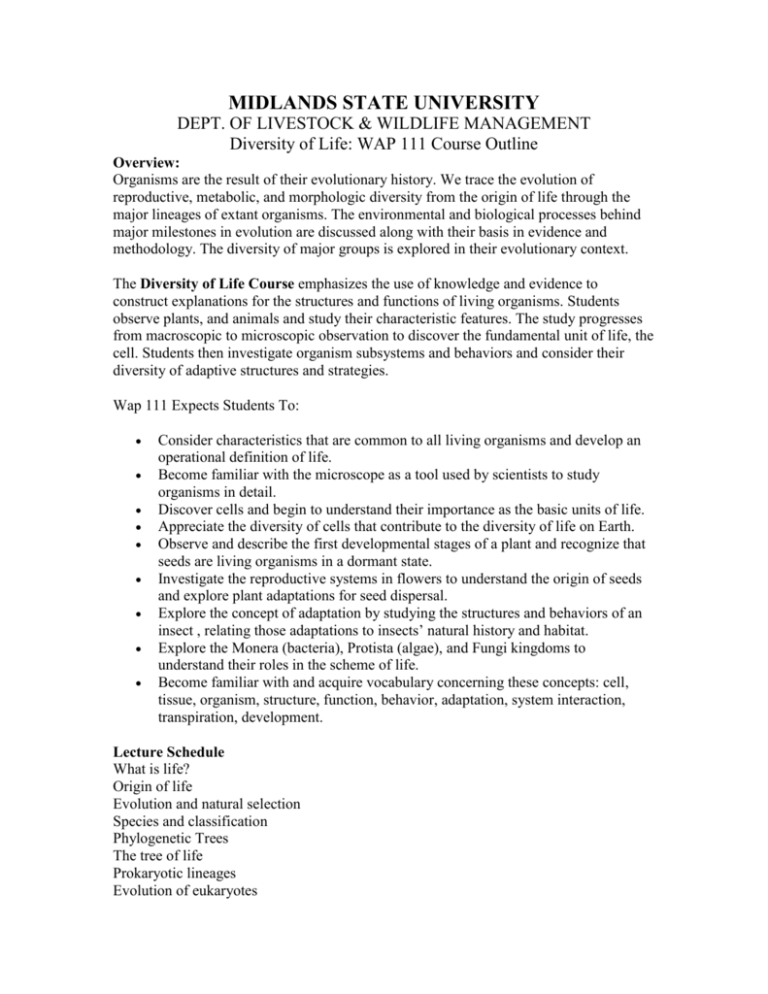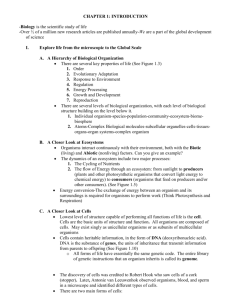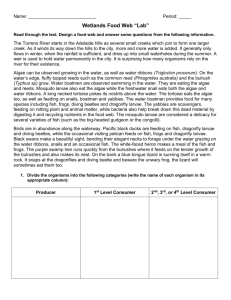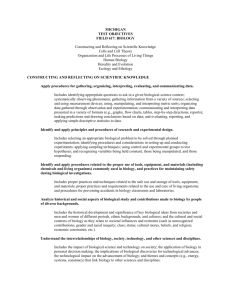Diversity of life Notes: WAP 111
advertisement

MIDLANDS STATE UNIVERSITY DEPT. OF LIVESTOCK & WILDLIFE MANAGEMENT Diversity of Life: WAP 111 Course Outline Overview: Organisms are the result of their evolutionary history. We trace the evolution of reproductive, metabolic, and morphologic diversity from the origin of life through the major lineages of extant organisms. The environmental and biological processes behind major milestones in evolution are discussed along with their basis in evidence and methodology. The diversity of major groups is explored in their evolutionary context. The Diversity of Life Course emphasizes the use of knowledge and evidence to construct explanations for the structures and functions of living organisms. Students observe plants, and animals and study their characteristic features. The study progresses from macroscopic to microscopic observation to discover the fundamental unit of life, the cell. Students then investigate organism subsystems and behaviors and consider their diversity of adaptive structures and strategies. Wap 111 Expects Students To: Consider characteristics that are common to all living organisms and develop an operational definition of life. Become familiar with the microscope as a tool used by scientists to study organisms in detail. Discover cells and begin to understand their importance as the basic units of life. Appreciate the diversity of cells that contribute to the diversity of life on Earth. Observe and describe the first developmental stages of a plant and recognize that seeds are living organisms in a dormant state. Investigate the reproductive systems in flowers to understand the origin of seeds and explore plant adaptations for seed dispersal. Explore the concept of adaptation by studying the structures and behaviors of an insect , relating those adaptations to insects’ natural history and habitat. Explore the Monera (bacteria), Protista (algae), and Fungi kingdoms to understand their roles in the scheme of life. Become familiar with and acquire vocabulary concerning these concepts: cell, tissue, organism, structure, function, behavior, adaptation, system interaction, transpiration, development. Lecture Schedule What is life? Origin of life Evolution and natural selection Species and classification Phylogenetic Trees The tree of life Prokaryotic lineages Evolution of eukaryotes Protozoans: heterotrophic protists Origin of the Algae and Algal diversity Reproductive biology of algae Evolution of land plants Bryophytes: non-vascular plants Seedless vascular plants. Evolution of seed plants Gymnosperms. Angiosperms Fungi: Chitrids, zygomycetes, ascomycetes ;& Basidiomycetes, deuteromycetes; symbioses Animal origins, body plans & phylogenetic hypotheses Rise of metazoans Radiate phyla.Origins of Bilateria. Flatworms: Planarians, flukes & tapeworms Origins of body cavities; Rotifers & nematodes Protostomia: Mollusca Protostomia: Annelida Protostomia: Arthropoda Echinoderms Vertebrates: Fishes Vertebrates: Tetrapods End of Diversity Textbook/Readings: Required Readings: 1. Campbell & Reece, Biology 7th edition. 2. Raven and Johnson, Biology. 6th edition 3. Journal articles or other readings as announced. 4. Any basic biology textbook and there are plenty in the library. Use the library please. During exam week there will be an additional review discussion session(s). Attendance and lecture notes: You are expected to attend all lectures. You are responsible for taking your own notes during lecture. If unavoidable circumstances prevent you from attending a lecture, obtain lecture notes from someone else in the class. Lecture notes will not be provided the lecturer outside lecture times. Grading: The final grade is based on a total of 100 points. There will be 2 assignments and one class test which constitute 30% of your final mark. The exam mark contributes 70% of your final grade. Exams will be based on lecture material and required readings. The best study guide for the exams are your own lecture and discussion notes. The homework assignments are take home exercises that consist of study problems similar to those you will encounter on the exams. You may discuss the exercises with other students but your written answers must be your own work. Late exercises will be subject to mark deduction, and their safe handling cannot be guaranteed.











